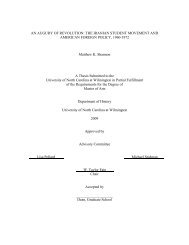HIERARCHAL INDUCTIVE PROCESS MODELING AND ANALYSIS ...
HIERARCHAL INDUCTIVE PROCESS MODELING AND ANALYSIS ...
HIERARCHAL INDUCTIVE PROCESS MODELING AND ANALYSIS ...
Create successful ePaper yourself
Turn your PDF publications into a flip-book with our unique Google optimized e-Paper software.
5 CONCLUSION<br />
The hierarchal inductive process-modeling framework was effective in its role to cover<br />
two very extensive search spaces in a short amount time and with the availability of<br />
the CIAO data I was able to investigate the usefulness of the software in our search<br />
for the best model representation.<br />
Some of the major observations that can be made throughout this paper are<br />
about the Zooplankton state variable.<br />
Not only did it tend to provide great restrictive<br />
power when its time series was inputted into HIPM as portrayed with its<br />
median activation value and Table 4, but most often some of the good fit models<br />
I selected only differed in the type of Zooplankton grazing process chosen. All<br />
this may suggest one of two things.<br />
Either, that indeed Zooplankton yields the<br />
most important discriminatory power out of all state variables and is the data that<br />
should be collected first and foremost for the Ross Sea ecosystem, or that the way<br />
the Zooplankton entity is defined in the HIPM framework is inadequate for this<br />
type of ecosystem which incidentally weeds out many of the model that are being<br />
searched through (i.e. all the zeros in Table 4 ). This makes for high variability in<br />
structure for the good fit models selected which in turn creates an array of dynamic<br />
some of which are at opposite end of the spectrum (i.e. zooplankton population<br />
going to extinction in some case or going to the carrying capacity in other) when<br />
HIPM is provided with time-series data that are not that of Zooplankton. The other<br />
explanation about the issues encountered with Zooplankton could be found not in<br />
the way Zooplankton is defined in the process library but rather in an assumption<br />
made within the biological knowledge encoded into HIPM. Indeed, Phaeocystis are<br />
assumed to be grazing resistant to zooplankton, meaning that it is more difficult for<br />
zooplankton to graze upon on Phaeocystis than it is on diatoms; the later not being<br />
included in the process-library as we will discuss later on. Hence, the inability for<br />
65
















